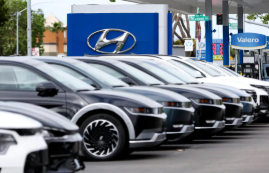Industry analysts predict that next year’s U.S. new car sales will reach their highest level since 2019 due to improved affordability and reduced financing rates.
Cox Automotive anticipates 16.3 million new light-duty vehicle sales in 2025, which is somewhat more than S&P Global Mobility and Edmunds’ projections of 16.2 million sales in the same year. These sales would be the highest figures since almost 17 million in 2019 and would increase from projections of 15.9 million to 16 million this year.
That would correspond to a 2.5% or less predicted increase in new automobile and truck sales. Automakers’ incentives and discounts, relaxing finance and lending rates, and the ongoing “normalization” of car stocks are anticipated to be the main drivers of the increase.
According to a Tuesday statement from Edmunds’ head of insights, Jessica Caldwell, “although consumers are still feeling the pinch, the market has become a slightly friendlier place for car shoppers than it was at the beginning of the year.”

Entry-level and less costly automobiles are predicted to be one of the biggest growing areas. Since the coronavirus epidemic, the business has had to contend with years of higher pricing and decreased inventory.
According to Edmunds, the average transaction price for new cars in 2024 was $47,465—a 27.2% increase over $37,310 in 2019 and a 0.8% reduction from $47,851 in 2023.
EVs
Analysts predict that electrified cars, such as hybrid, plug-in hybrid, and all-electric versions, will continue to be a growing sector.
According to Cox, the number of all-electric vehicles sold in the United States is expected to reach 1.3 million in 2024, setting yet another record. That would represent around 8% of the market, which is more than the 7.6% it had last year but less than the 10% predicted early this year.
That’s even if sales of the leading EV in the US, Tesla, are predicted to drop year over year for the first time since 2014.
Tesla, Hyundai Motor Group, and General Motors are the top three manufacturers. At the brand level, GM has seen the most growth in market share year over year, at 2.7%.
The top two positions are still occupied by the Model Y and Model 3, despite Tesla’s market share falling below 50%, according to Stephanie Valdez Streaty, director of industry analytics at Cox, on Tuesday. “A number of other models are collectively reducing Tesla’s market share.”
In 2025, Cox predicts that over 25% of new car sales will be electric, with over 10% of those sales going to all-electric cars.
Valdez Streaty and others warned that if federal consumer subsidies of up to $7,500 for buying EVs are eliminated—something the Trump administration has pledged to do—EV sales may suffer.
“Crazy disruption”?
Analysts cautioned that new U.S. car sales may be impacted by regulatory uncertainties before to President-elect Donald Trump’s inauguration. Most significantly, the manufacture of automobiles in Canada and Mexico may be impacted by Trump’s tariff threats.
Tariffs on those nations, which Trump has suggested may reach 25%, would cause “a radical disruption” to the U.S. new car industry, according to Jonathan Smoke, chief economist at Cox Automotive.
During a virtual briefing on Tuesday, Smoke stated, “We are aware that there may be potential twists with policy changes, but some important assumptions that we’re making are that most of those shifts are likely to take time, and before they’re implemented, will actually likely drive demand to be pulled forward.” “With regard to tariffs in particular, we are not assuming that significant new tariffs will be imposed.”
According to Wall Street analysts, greater incentive rates and a predicted drop in price might make the anticipated growth in U.S. new car sales next year counterproductive for certain automakers’ profitability.
Colin Langan, an analyst at Wells Fargo, stated in an investor letter on Monday that “we continue to see signs that pricing is not sustainable.” He cited a number of factors, including declining dealer earnings per car, rising inventories, and an overall decrease in manufacturers’ pricing power.
Although growth has moderated, prices are still close to record highs, which is excellent for consumers but terrible for automakers.





